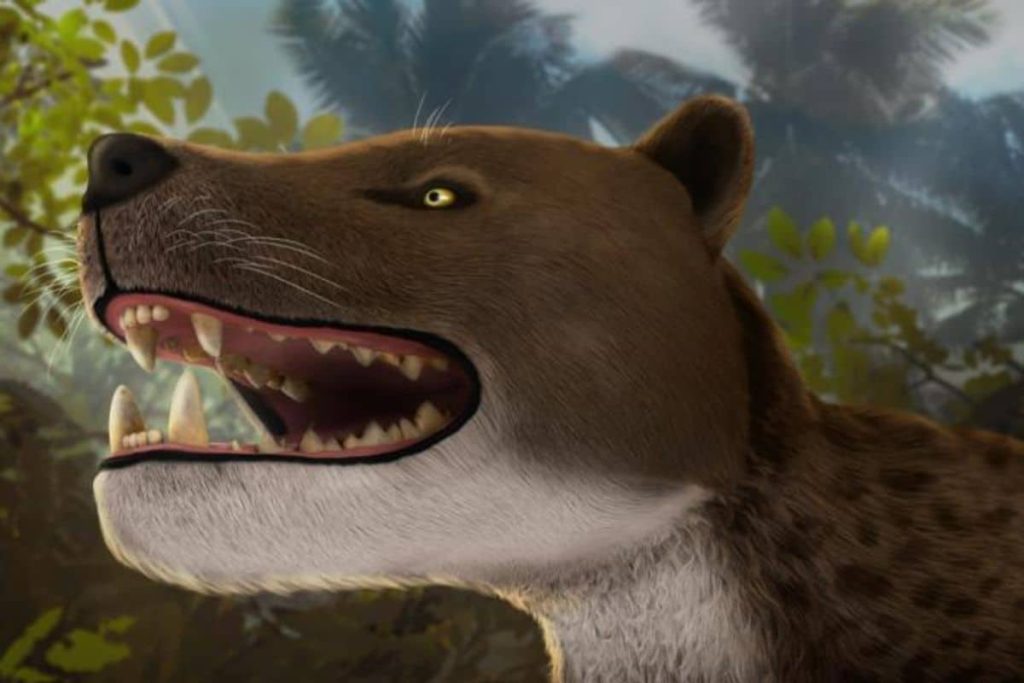Scientists Uncover 15-million-year-old Skull Of A Fearsome Hypercarnivore – The Daily Galaxy –Great Discoveries Channel

Scientists in Egypt have unearthed the nearly complete skull of Bastetodon syrtos, a long-lost apex predator that once ruled Africa’s ancient ecosystems. This rare discovery sheds new light on the rise and fall of Hyaenodonta, a group of hypercarnivores that mysteriously vanished. What caused their extinction—and what secrets does this fossil reveal?Paleontologists in Egypt have unearthed a nearly complete skull of a Hyaenodonta, an extinct group of apex predators that once dominated African ecosystems. The discovery, made in the Fayum Depression, sheds new light on the evolution of these hypercarnivores, which thrived for millions of years before vanishing in the late Miocene.Named Bastetodon syrtos, this leopard-sized predator may have stalked early elephants, hippopotamuses, and even primate ancestors. The fossil, described in the Journal of Invertebrate Paleontology, provides a crucial link in understanding how these fearsome carnivores spread across the globe before their decline.The newly identified Bastetodon syrtos belonged to the order Hyaenodonta, a now-extinct group of carnivorous mammals unrelated to modern hyenas despite their name. These animals ruled ancient ecosystems with a specialized diet consisting of at least 70 percent meat, classifying them as hypercarnivores. With powerful jaws and razor-sharp teeth, B. syrtos likely occupied the top of the food chain in Oligocene Africa.Discovered in the Fayum Depression, an area rich in fossils spanning millions of years, the skull of B. syrtos provides paleontologists with a rare glimpse into a time when these carnivores thrived. The Fayum region, now a desert, was once a lush ecosystem teeming with life, from early proboscideans (ancestors of modern elephants) to the distant relatives of modern hippos. B. syrtos would have hunted these animals with precision, shaping the food web of its time. The excavation team, composed of researchers from Mansoura University and The American University in Cairo, almost overlooked this extraordinary find. After days of carefully excavating rock layers dating back 30 million years, they were about to conclude their work when a team member spotted an unusual set of teeth emerging from the ground.“Just as we were about to conclude our work, a team member spotted something remarkable—a set of large teeth sticking out of the ground. His excited shout brought the team together, marking the beginning of an extraordinary discovery: a nearly complete skull of an ancient apex carnivore, a dream for any vertebrate paleontologist,” said Shorouq Al-Ashqar, lead author of the study.This chance discovery has allowed scientists to reevaluate existing fossils of related species, including Sekhmetops, another hyaenodont named after the lion-headed Egyptian goddess Sekhmet. Despite their dominance for millions of years, Hyaenodonts eventually faced extinction in the late Miocene, roughly 5 to 7 million years ago. Their decline is believed to have resulted from a combination of factors, including climate change, competition from emerging carnivore species, and evolutionary disadvantages.The rise of feliforms (ancestors of modern cats) and caniforms (ancestors of dogs and bears) introduced new, more adaptable predators that may have outcompeted Hyaenodonta. These newer carnivores possessed better hunting strategies, greater stamina, and a more efficient use of their environment, leading to the eventual disappearance of the once-dominant hyaenodonts.The discovery of Bastetodon syrtos is a major breakthrough in understanding ancient predators and their role in shaping ecosystems. As one of the most complete hyaenodont skulls ever found, it provides researchers with critical insights into the diversity and global distribution of these formidable hunters.“The discovery of Bastetodon is a significant achievement in understanding the diversity and evolution of hyaenodonts and their global distribution,”said Shorouq Al-Ashqar. “We are eager to continue our research to unravel the intricate relationships between these ancient predators and their environments over time and across continents.”Comment Save my name, email, and website in this browser for the next time I comment.
© 2024 | Daily Galaxy | All rights reserved
Source: https://dailygalaxy.com/2025/02/scientists-uncover-skull-hypercarnivore/






